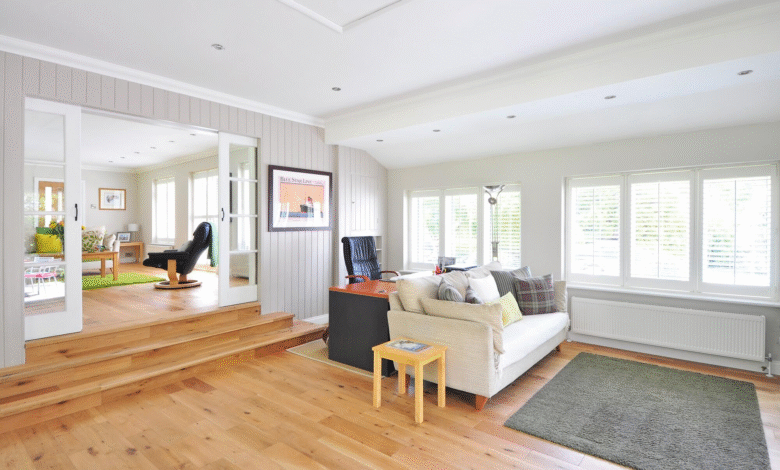How to Choose the Perfect Flooring for Your Home

Choosing the right flooring affects how a space feels and functions. The look, texture, and durability all play a role. Every room has different needs, so not all floors work everywhere. Some need to handle moisture, while others need to feel warm and soft.
Flooring also impacts cleaning routines and energy use. With so many options, it’s easy to feel overwhelmed. The good news is that there’s a match for every space.
To find the perfect flooring for your home, keep reading as we break down your choices by type and use.
Hardwood Flooring
Hardwood flooring offers a classic look that works well in bedrooms, living rooms, and dining spaces. It brings warmth and timeless style to any room. Common species include oak, maple, and walnut, each offering its own color and grain.
While it’s durable and long-lasting, hardwood is not ideal for areas with high moisture like bathrooms or basements. Over time, water exposure can lead to warping and damage.
Hardwood can be sanded and refinished to restore its appearance, making it a good long-term investment. It also boosts home value and suits many interior styles. Stain options range from light to dark, helping match your decor. Wide planks can give a space a more modern feel.
Engineered Wood Flooring
Engineered wood looks like hardwood but is made with multiple layers for added stability. It’s more resistant to humidity and temperature changes, making it a better fit for kitchens and basements.
The top layer is real wood, while the core is usually plywood or fiberboard. This construction limits expansion and contraction. Installation is often easier, with floating options that lock together.
While it can’t be refinished as many times as solid wood, it still offers a good lifespan. Finishes and textures vary widely, from matte to high gloss. It works with radiant heating systems for added comfort. Engineered wood also handles slight imperfections in subfloors better than solid wood.
Laminate Flooring
Laminate is a multi-layer synthetic product designed to look like wood or stone. It has a photographic surface layer and a tough wear layer that resists scratches. It’s ideal for high-traffic areas like hallways or living rooms.
Laminate is also budget-friendly and easy to install using a click-lock system. It’s not waterproof, so it shouldn’t be used in bathrooms or other wet spaces. Daily maintenance is simple-just sweep or vacuum.
Some products include attached underlayment to improve comfort and sound absorption. It’s a practical choice for families with kids and pets. Laminate offers various textures, including embossed and hand-scraped designs.
Vinyl Plank Flooring
Vinyl plank flooring is waterproof and ideal for moisture-prone areas like kitchens and bathrooms. It’s designed to look like hardwood but is more resilient to daily wear.
The planks are softer and quieter than real wood, making them comfortable underfoot. Installation is straightforward, even for DIY projects. Most planks are click-together and don’t require glue or nails.
It’s resistant to stains, scratches, and spills. You can install it over most subfloors, including concrete. Some styles have textured surfaces for added slip resistance. It’s a reliable option for homes with pets or children.
Luxury Vinyl Tile (LVT)
Luxury vinyl tile combines durability with a high-end appearance. It can mimic the look of stone or ceramic while being warmer and softer. LVT is fully waterproof and resists stains and dents.
It’s a smart pick for entryways, basements, and bathrooms. Some tiles are groutable, offering a more authentic look. Installation can be glued down or floated, depending on the subfloor.
It works well with radiant heating. The wear layer protects the surface from scratches and fading. It’s an affordable way to get a luxury look with practical benefits.
Tile Flooring
Tile is one of the most durable flooring types, commonly used in wet and high-traffic areas. It includes materials like ceramic, porcelain, and natural stone. Glazed tiles are easy to clean and don’t stain easily.
They’re ideal for kitchens, bathrooms, and mudrooms. Tile comes in many sizes, shapes, and finishes. Proper installation is crucial to avoid cracking or uneven surfaces.
Grout lines need sealing to prevent water damage. While tile can feel cold, it pairs well with underfloor heating. Tile offers limitless design options for both modern and traditional spaces.
Carpet Flooring
Carpet brings softness, warmth, and sound insulation to a room. It’s most commonly used in bedrooms and living rooms. There are various textures, from plush to looped, each with different comfort levels.
Thicker carpets provide cushioning but may be harder to clean. Low-pile options are better for high-traffic zones. Carpet reduces noise and helps keep spaces warmer.
It does require regular vacuuming and occasional deep cleaning. Some carpets come with stain-resistant treatments, making maintenance easier. Layering with rugs adds visual interest and extra softness.
Cork Flooring
Cork is a natural and renewable flooring option made from tree bark. It’s soft underfoot, absorbs sound, and retains warmth. That makes it great for bedrooms, offices, or play areas.
Cork is resistant to mold and mildew, but it must be sealed to prevent moisture damage. It’s easy to install with floating tile or plank systems. Its surface can compress under heavy furniture, so use floor protectors.
The material has a distinct texture and earthy color. Cleaning involves sweeping and occasional damp mopping. It’s an eco-friendly alternative to synthetic options.
Bamboo Flooring
Bamboo is a sustainable option that looks and performs like hardwood. It’s harder than many traditional woods and resists dents well. Strand-woven bamboo is the most durable form, ideal for busy households. It handles humidity better than oak but should still be kept dry.
Direct sunlight can fade bamboo over time, so window treatments are helpful. It comes in both solid and engineered forms. Occasional resealing protects the surface from moisture and wear.
Bamboo cleans easily with a microfiber mop. Its sleek look works in both modern and rustic interiors.
Concrete Flooring
Concrete flooring offers a minimalist, industrial feel. It’s extremely durable and can be stained, stamped, or polished for a custom look. Common in basements and ground-level spaces, it resists heavy traffic and moisture.
Sealing is necessary to prevent staining and cracking. Though hard underfoot, concrete works well with area rugs for added comfort. It retains heat in winter, making it more energy-efficient than expected.
Maintenance involves sweeping and occasional mopping. Its smooth, clean surface suits modern open-plan layouts. Concrete can serve as a finished floor or subfloor.
Natural Stone Flooring
Natural stone floors provide elegance and unique character. Each piece of stone offers its own color and texture, creating a one-of-a-kind look. Popular choices include marble, slate, and travertine.
Stone is best for entryways, kitchens, and bathrooms where durability is important. It needs sealing to protect against stains and moisture. Stone tends to be cold and hard underfoot but pairs well with radiant heating systems.
Cleaning requires non-acidic products to avoid etching. It’s a premium option that adds value to the home. Stone floors work well in both modern and traditional designs.
Carpet Tiles
Carpet tiles are a flexible flooring solution that allows easy replacement and creative design. They are commonly used in basements, home offices, and playrooms. The tiles can be mixed and matched for custom patterns and styles.
Damaged or stained tiles can be swapped out without needing to replace the entire floor. Many options come with built-in padding for extra comfort.
Installation is simple and doesn’t require glue. They offer a modern, practical solution for multi-use spaces. Carpet tiles also provide good noise control. It’s a smart pick for families or areas with changing needs.
Rubber Flooring
Rubber flooring is highly durable and provides excellent cushioning. It’s commonly used in home gyms, playrooms, and garages. The surface is slip-resistant and easy to clean. It can absorb impact, which makes it great for exercise areas.
Available in tiles or rolls, it’s simple to install and replace. Rubber flooring comes in various colors and patterns. It resists moisture, mold, and mildew.
Some styles are made from recycled materials, making it an eco-conscious choice. It offers sound insulation and comfort for standing long periods.
Terrazzo Flooring
Terrazzo is a mix of marble, quartz, or glass chips in a cement or resin base. It creates a smooth, colorful surface with a high-end look. It’s known for its long lifespan and resistance to wear.
Terrazzo works well in hallways, kitchens, and bathrooms. Installation is complex and best left to professionals. Once sealed, it becomes stain- and moisture-resistant.
It’s easy to clean with regular sweeping and damp mopping. Terrazzo adds artistic flair to floors with its unique patterns. It’s a strong choice for modern and luxurious interiors.
Pebble Stone Flooring
Pebble stone flooring offers a natural, textured look for bathrooms, showers, or patios. It provides grip underfoot and feels like a spa surface. Installation includes individual stones set in mesh sheets and sealed with grout.
It’s best in small areas due to its bold visual impact. The surface must be sealed regularly to prevent mold. Cleaning involves scrubbing with gentle cleaners and resealing as needed.
The stones come in different colors, shapes, and sizes. It pairs well with modern and tropical design themes. Pebble flooring offers a relaxing, organic aesthetic.
Reclaimed Wood Flooring
Reclaimed wood uses salvaged boards from old buildings or barns. Each plank carries unique markings and history. It’s ideal for rustic, farmhouse, or vintage interiors.
Reclaimed wood supports sustainability by reusing existing materials. It’s typically more expensive due to its rarity and prep work. The wood may be harder and more stable than new lumber.
It often requires custom installation due to board variation. Finishing can highlight aged textures and patinas. It brings character and authenticity to a space.
Epoxy Flooring
Epoxy floors are made by applying a resin coating over concrete. They create a glossy, smooth surface that’s strong and chemical-resistant. This makes them great for garages, basements, and utility rooms.
Epoxy resists oil, grease, and stains. It’s easy to mop and maintain over time. Colors and patterns can be customized, including metallic or flake finishes. The surface is waterproof and seamless.
Installation needs proper prep and curing time. Epoxy offers a clean and modern appearance.
Ceramic and Porcelain Tile Flooring
Ceramic and porcelain tile are popular due to their durability and wide range of designs. Porcelain is denser and more water-resistant than ceramic, making it better for wet areas.
Both are easy to clean and resist stains. They come in various finishes like matte, polished, or textured. Installation can be labor-intensive but offers long-lasting results. They handle heavy foot traffic well.
These tiles stay cool, making them suitable for warm climates. Ideal for kitchens, bathrooms, and laundry rooms. For reliable, stylish, and functional flooring, ceramic and porcelain tile is a smart option.
Mosaic Tile Flooring
Mosaic tiles come in small, intricate patterns and are often used in bathrooms or accent spaces. Materials include glass, ceramic, and natural stone. The tiles are mounted on mesh sheets for easier installation.
Patterns range from simple grids to elaborate designs. Mosaic tiles pair beautifully with larger tile formats for contrast. The grout lines provide slip resistance.
They need sealing to resist moisture and stains. Cleaning involves a gentle brush and mild cleaner. Mosaic floors add artistic value and fine detail.
Parquet Flooring
Parquet flooring is made of small wood pieces arranged in decorative patterns. Popular styles include herringbone and chevron. It gives a space a refined, classic look.
Often used in formal living rooms and hallways. Parquet can be made from solid or engineered wood. It requires precise installation for symmetry.
Finishes include matte or glossy depending on the interior theme. It can be sanded and refinished over time. Parquet adds visual interest and texture to flooring.
Be Sure to Choose the Perfect Flooring for Your Home
Flooring should fit the space, budget, and lifestyle. No one option works everywhere. Some floors work better in damp areas, others feel better in cozy spaces. Focus on function first, then design.
Pick materials that handle wear and match your style. Keep maintenance in mind too. The perfect flooring for your home is one that fits your everyday life while elevating the space.
Think about the needs of each room. Then choose the floor that delivers long-term value.
Should you wish to read more, visit our blog page. We’ve got more topics! NewsDipper.co.uk

